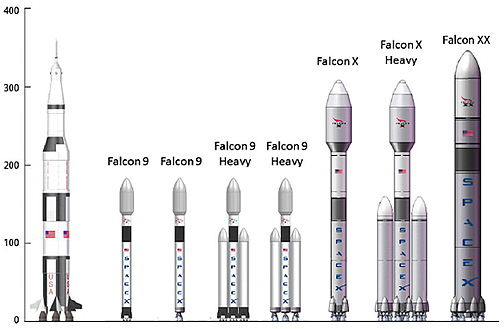
NASHVILLE, Tenn. — The U.S. government should lead development of a nuclear thermal propulsion system for a future Mars mission and leave new heavy-lift launchers to commercial entities, Space Exploration Technologies (SpaceX) says.
Unveiling conceptual plans for a family of Falcon X and XX future heavy-lift vehicles at last week’s AIAA Joint Propulsion conference here, SpaceX McGregor rocket development facility director Tom Markusic said, “Mars is the ultimate goal of SpaceX.”
The company, which until now has focused mostly on development of vehicles to transport cargo and humans to low Earth orbit (LEO), believes its Falcon 1 and Falcon 9 launchers could be evolved into a heavy-lift family that will provide the basis for a Mars-capable architecture.
For the transition from Earth to Mars, however, SpaceX believes nuclear thermal is the preferred propulsion means for the piloted aspect of the mission, while solar-electric power could be used to transport supplies.
The U.S. government “should take the lead on nuclear and commercial industry should take the lead on building heavy-lift launch vehicles,” Markusic says. “Low-level propulsion technology research and development should be government-led, with a transition to flight development in 2025.”
Markusic’s call flies in the face of SpaceX’s usual advocacy for industrially driven competition and Commercial Orbital Transportation Services (COTS)-like procurement. However, he says “the government should only lead the propulsion element development where there is no existing commercial capability, or a high risk of capital loss.”
For cargo to Mars, SpaceX’s architecture suggests tugs powered by clusters of solar-electric powered thrusters. The 100-kw. tugs each would carry around 4 metric tons of payload and take 390 days for the round trip.
The plan envisages a fleet of up to 10 tugs rotating between LEO and Mars orbit, with vehicles being serviced and turned at a terminus based on the International Space Station.
For landing and ascending on Mars or its moon Phobos, SpaceX is proposing a liquid oxygen (Lox)/methane powered propulsion system capable of delivering a payload of approximately 35 metric tons. In-situ derived methane could be used for fuel, while existing engines now in development by ATK or Xcor Aerospace could provide the basis for initial units.
SpaceX’s long-discussed Merlin 2 Lox/rocket propellant-fueled engine, capable of a projected 1.7 million lb. of thrust at sea level and 1.92 million lb. in a vacuum, would provide the power for the Falcon X and XX heavy launch vehicles.
Slated to be introduced on more capable variants of the Falcon 9 Heavy, the Merlin 2 “could be qualified in three years for $1 billion,” Markusic says.
Three Merlin 2s would power the first stage of Falcon X, a 300-ft. plus tall vehicle capable of placing 38,000 kg. in LEO.
A growth development, dubbed Falcon X Heavy, would employ nine engines clustered in three cores. Collectively these would generate 10.8 million lb. of thrust at liftoff and boost 125,000 kg. to orbit. The ultimate launch vehicle, the Falcon XX, stands as tall as the Saturn V, is configured with six engines in a single core and is designed to lift 140,000 kg. to LEO.
“It’s just a question of is it going to be our generation or the next that’s going to do these things,” Markusic says. “I think there’s a growing wave of people who’d like to do this. It’s really critical to just get started. There’s an incredible amount of technology out there that we can grab. A piloted mission to Mars by 2020-2025 can be accomplished if we start building and testing hardware now.”

Photo Credit: SpaceX
SpaceX Unveils Heavy-Lift Vehicle Plan | AVIATION WEEK



















